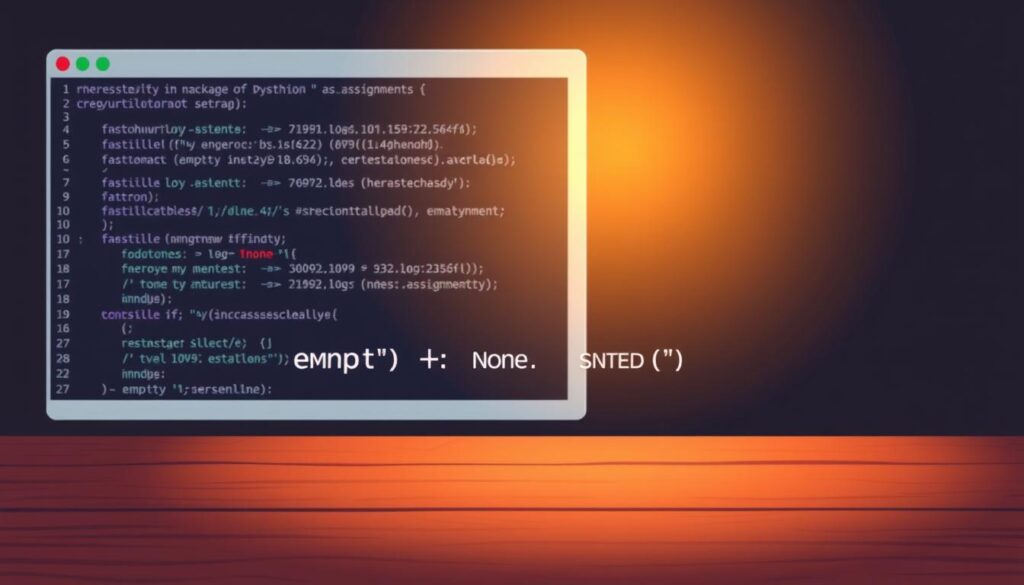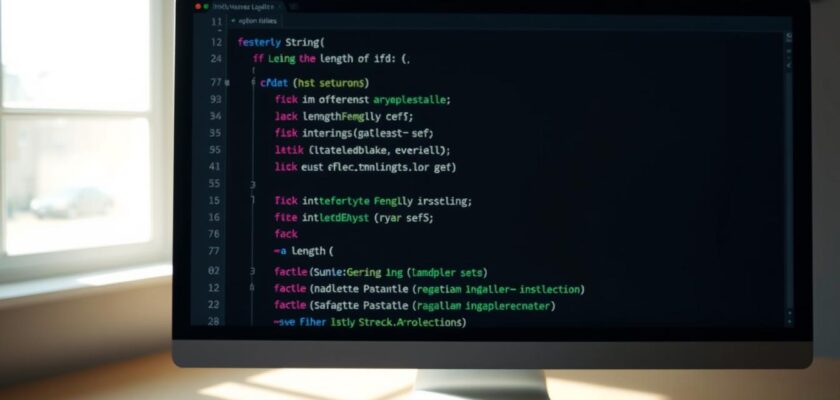What if your code’s reliability hinges on a single overlooked detail? Imagine spending hours debugging an app, only to discover unverified text data caused the crash. How do you confirm blank inputs efficiently?
This guide explores straightforward techniques to validate text-based information in your programs. Whether you’re handling user inputs or processing files, knowing how to identify empty content prevents unexpected errors and streamlines data workflows.
We’ll break down three core approaches: direct comparisons, length evaluations, and leveraging Python’s unique truth evaluations. Each strategy includes practical snippets to help you implement them immediately. By the end, you’ll understand which technique suits different scenarios—from basic validations to handling edge cases.
Key Takeaways
- Learn multiple approaches to validate text data effectively
- Discover how comparison operators simplify empty content detection
- Understand when to use length checks versus truth evaluations
- Explore real-world code samples for immediate implementation
- Prepare for advanced scenarios like whitespace-only inputs
Introduction to Empty String Checks in Python
Data validation forms the backbone of error-free applications. Without proper verification, even minor oversights like unvalidated text fields can disrupt entire workflows. Let’s explore why identifying blank content matters and how to approach it systematically.
Purpose and Importance of the Check
An empty sequence contains zero characters. Think of login forms rejecting blank passwords or APIs ignoring incomplete requests. These scenarios demand precise validation to avoid crashes during data operations.
Consider a program expecting user input but receiving nothing. Without checks, it might attempt invalid operations like splitting non-existent text. Proper verification ensures your code handles all edge cases gracefully.
Overview of Simple Methods
Three primary techniques help detect blank content:
- Direct comparison: Match against two quotes (
"") - Length evaluation: Use
len()to confirm zero characters - Truth evaluation: Leverage Python’s falsy treatment of empty sequences
Each method serves different needs. For example, len() works best when tracking character counts, while truth evaluations simplify conditional statements. We’ll dissect these approaches next to help you choose wisely.
How to python check if string is empty: Comparison and Truthiness
When coding, sometimes the smallest details make the biggest difference. Let’s explore two fundamental techniques to verify text content in your applications.

Using the Comparison Operator (==)
The equality operator offers a straightforward way to detect blank sequences. Compare your text variable directly to an empty pair of quotes like this:
user_input = ""
if user_input == "":
print("No text detected")This method leaves no room for ambiguity. It’s perfect when you need explicit validation and want to avoid accidental matches with other falsy values like None.
Leveraging Truthy/Falsy Behavior
Python treats empty sequences as falsy in conditional statements. Here’s how to use this feature:
data_stream = ""
if not data_stream:
print("Ready for new input")This approach simplifies code readability. However, be cautious—it will also treat values like None or 0 as falsy in some contexts.
Choosing your approach:
- Use
== ""for strict validation - Opt for truthy checks when conciseness matters
- Combine both methods for robust data handling
Both techniques appear frequently in professional codebases. The best choice depends on whether you need precision or brevity in your specific scenario.
Validating Empty Strings with the len() Function
Measuring character counts offers precision where other methods might falter. The len() function provides a numerical approach to text validation, making it ideal for scenarios requiring explicit confirmation.
Implementation and Code Example
This built-in tool returns the total number of elements in a sequence. When applied to text, it counts every character—including spaces and invisible symbols. A result of zero means you’ve got blank content.
user_input = ""
if len(user_input) == 0:
print("Input field cannot be blank")This approach shines in form validations or data processing pipelines. Unlike truthy checks, it ignores other falsy values and focuses solely on character quantity. Beginners often prefer this method for its straightforward logic.
Three key advantages make len() stand out:
- Clear numerical output eliminates guesswork
- Works identically across all sequence types
- Easily adapts to minimum length requirements
While simple, this technique forms the foundation for more complex validations. Combine it with whitespace stripping or None checks for robust data handling in real-world applications.
Handling None When Validating String Content
Not all missing data looks the same. While empty text contains zero characters, None represents the complete absence of value. Confusing these states can lead to crashes when processing information.

Checking for None vs. Empty Strings
Always verify if a variable holds None before evaluating its content. The identity operator (is) works best here:
user_data = None
if user_data is None:
print("Data unavailable")
elif user_data == "":
print("Empty input detected")Unlike the equality operator (==), is checks whether two variables reference the exact same object. This distinction matters because:
Noneisn’t equal to empty text- Using
== Nonecan produce false positives
Consider an API returning None for missing entries. Attempting to call string methods like .strip() on this value would trigger an AttributeError. Validating existence first prevents these runtime exceptions.
“Treat None like a missing puzzle piece – identify it before handling what’s present.”
Combining checks creates robust validation:
def process_text(input_value):
if input_value is None:
return "No data received"
elif not input_value.strip():
return "Blank content"
else:
return input_value.upper()This approach handles both missing values and whitespace-only inputs gracefully. Remember: clear data boundaries make your code predictable and error-resistant.
Advanced Considerations for Python String Validation
Real-world data often throws curveballs that simple checks miss. Combining validation techniques creates airtight defenses against unexpected values. Let’s explore how to handle complex scenarios while keeping code clean.
Combining Methods: Empty and None Checks
Merge existence and content verification in one step. This approach catches both missing values and blank text:
def validate_input(user_value):
if user_value is None or user_value == "":
return "Invalid entry"Always test for None first using is. This prevents errors when calling methods on non-existent objects. The order matters—checking for emptiness before existence might crash your program.
Best Practices and Pitfalls
Three rules prevent common mistakes:
- Use
is Noneinstead of== Nonefor object identity - Group related checks using parentheses for clarity
- Test edge cases like whitespace-only inputs separately
Many developers stumble by using equality operators with None. Remember: None is a singleton object—identity checks (is) work faster and more reliably.
“Good validation acts like a safety net, not a straitjacket—it catches falls without restricting movement.”
Thorough testing catches hidden issues. Create test cases for:
- Blank inputs with trailing spaces
- Null values from databases
- Unexpected data types
These strategies help build resilient applications that handle messy real-world information gracefully.
Conclusion
Mastering text validation gives you confidence in your program’s reliability. We’ve explored three core approaches: direct comparison with empty quotes, len() evaluations, and truthy behavior checks. Each method shines in specific scenarios—use equality operators for precision, and truthy tests for cleaner conditionals.
Remember the critical distinction between None and blank content. Always verify existence with is None before checking character counts. This prevents errors when handling incomplete data streams or external inputs.
Combine these techniques for robust validation. Test edge cases like whitespace-only entries using .strip(), and structure checks to handle null values first. Well-structured verification acts as your code’s safety net against unexpected crashes.
Review the provided code examples to see these strategies in action. Experiment with different combinations to find what works best for your projects. Thanks for exploring these essential skills—may your data flows remain error-free and your logic airtight. Happy coding!

